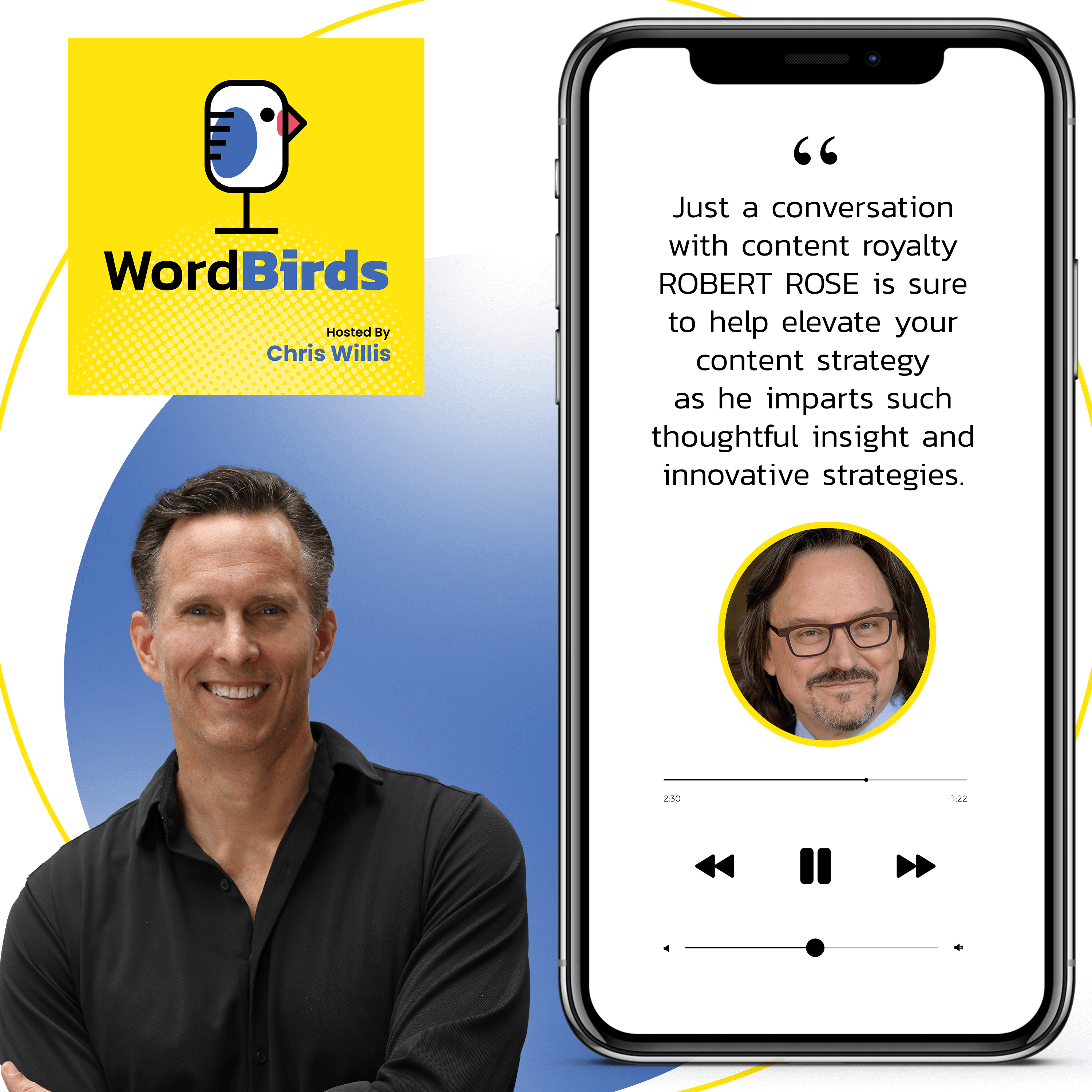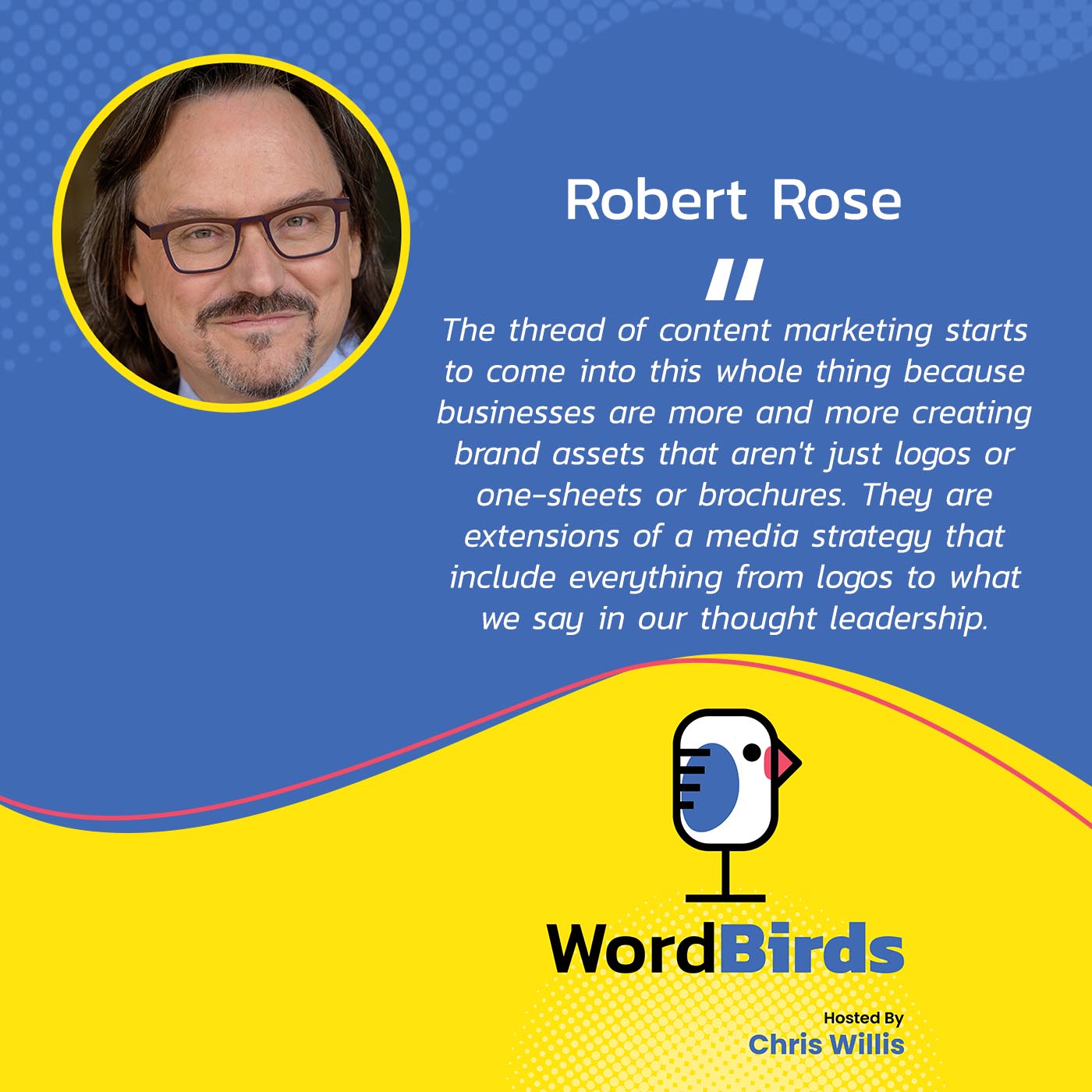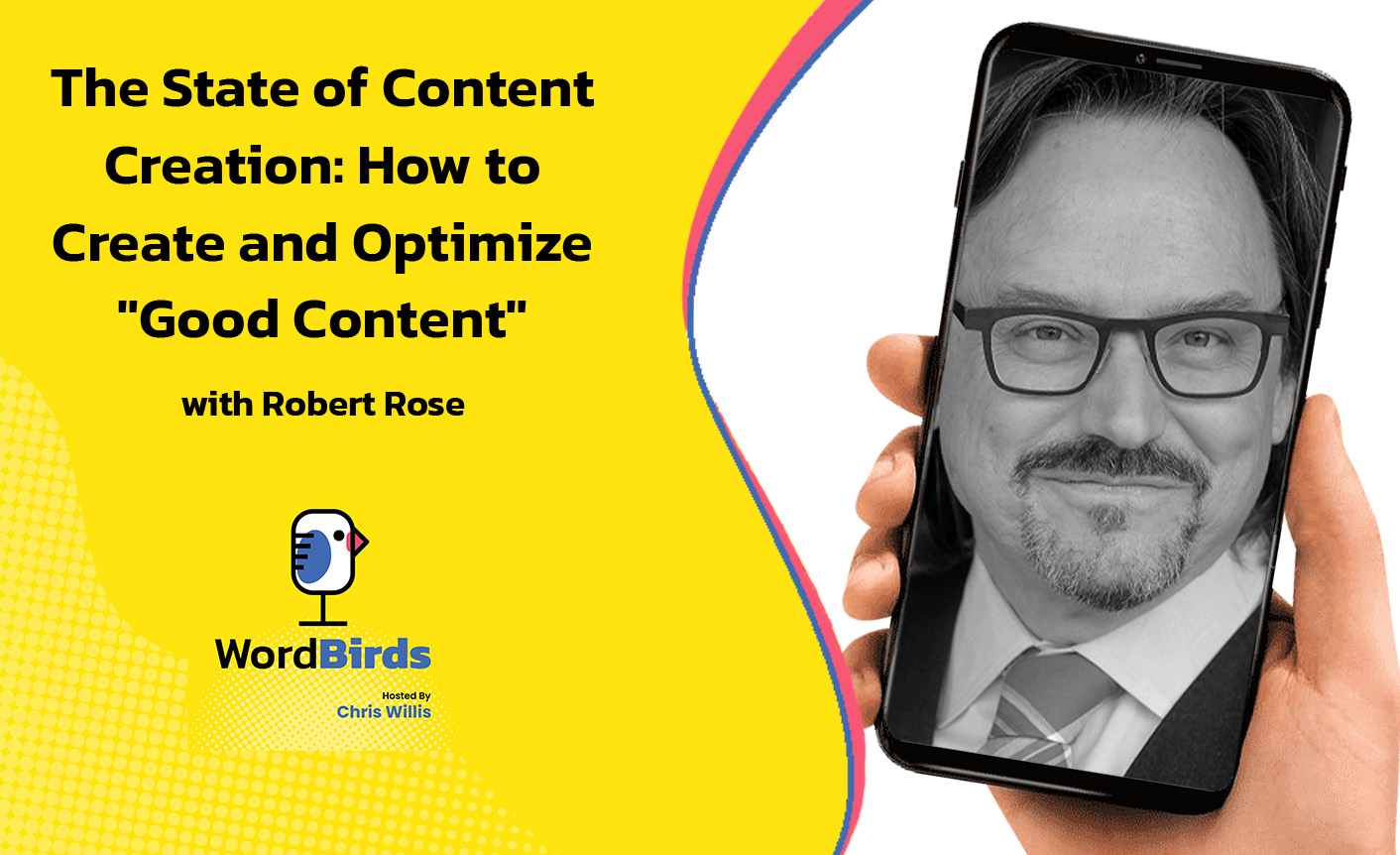More and more businesses are diving into content creation, but are they optimizing this marketing channel? What is “good content,” and how do you create it? Here to enlighten us on the topic is content royalty Robert Rose, CEO and Chief Strategy Officer for The Content Advisory. As one of the world’s most recognized experts in content strategy, digital media, and marketing, Robert innovates creative and technical strategies for a wide range of clients.
In this episode, Robert discusses the definition of good in content creation as well as the process and framework under which it drives content in the business. He also talks about what businesses need to do to take content to the level it should be to maximize its contribution to your growth. Take notes as Robert showers us with industry knowledge and expertise with helpful tips to boost your business.
Watch the full episode here
Listen to the podcast here
Read full episode transcript
In this episode, I am thrilled to be able to talk to Robert Rose. Robert Rose is the CEO and Chief Strategy Officer of The Content Advisory. He is content royalty.
We’re going to talk about things like the definition of good in content creation. We’re going to talk about the process or framework under which it drives content in the business. We’re going to talk about what we think businesses need to do to take content to the level it should already be in the business.
This is a super exciting episode. You’re going to like it. Let’s sit back and get some insight from the flock.
I’m super excited. Robert Rose, welcome to the show.
It’s great to be here. It’s amazing that we’re finally together.
This is exciting. I’m a bit of a fanboy. This is one of the more interesting conversations I’ve been ready to have. I’ve been following you for many years.
As companies, we’ve done a lot of things together over the years, but somehow, I’ve managed to miss you. To give everybody a sense of what happened before we kicked off, we talked a little bit about some things we thought might be interesting.
I want to continue that conversation about the confluence of content marketing and content strategy we’re both seeing in the market. I’d be super interested in hearing a little bit about what you think is happening there.
It’s an amazing thing. It’s something that many of us thought would happen years ago and predicted would happen.
We thought, “Content marketing is a thing. It will eventually become part of integrated marketing. It will no longer be this separate thing. It will be part of what it is we do.”
Content strategy, which has always been the dark science of business, back in the bowels of the cubes, there were very smart people doing smart things that nobody quite understands what it is they do, has been brought to the forefront. A lot of that has been accelerated by the last couple of years of crazy, weird stuff that’s been going on.
What we’ve seen is that as businesses have started to mature their digital practice and try to understand multiple channels, multiple formats, or multiple content platforms that are owned media platforms, social media and paid media platforms, etc., there has been this confluence of content marketing, which has classically been storytelling, editorial, and content delivered for value. The strategy of content has been, “How do we make content and asset in the business a structured, reusable, standardized, and operationalized function?” Those teams are coming together.
What we’re seeing is that as teams come together, there has been a very weird, discomforting thing that happened. These companies are building content studios, internal teams, or internal agencies in many cases. It’s interesting.

The ANA, or The Association of National Advertisers, has data on this to show that content is the driving force of this new in-housing trend, but they’re all failing. They’re all not doing well.
The reason they don’t do well is that they can’t scale. The reason they can’t scale is that they’re treated like an internal agency. They’re treated like the internal Kinkos of the business.
Without any strategy, process, or leadership, this is just content creation becoming everybody’s job but nobody’s strategy. This is the real challenge that we see in this confluence. It has risen to the point of, “We need to do something about this.”
When you think about the fact that because it is everybody’s job, the team dynamic is different than it was several years ago, so everything takes longer.
There’s this request for content coming from somewhere inside the business. The content team gets that request and sources this out to a subject matter expert who probably doesn’t work for the same management organization, so it goes off to product management to create a piece of content.
It comes back. It’s probably largely unreadable because these aren’t content creators. These are smart people that’re writing content.
There is the back and forth between the editorial and the content creator, and then finally, it goes off to the stakeholder who says, “That’s cool, but what if we did something slightly different?” It goes back to the beginning and finally comes back to somebody like me. I’m like, “This is cool. Have you talked to legal yet?” By the time it gets from legal back to the final content organization, nobody needs it anymore. It’s not even relevant.
This breakdown in the process starts to impact the overall ability to deliver in a timely manner. I’m talking to customers and guessing, “I’ll bet it takes you about six weeks to get a piece of premium content done.”
It’s amazing. I can’t remember who said it, but there’s a wonderful famous quote. It is, “Without standards, there can be no improvement.” That is the state of content creation processes.
Many businesses look at content as, “Magic things happen. We ask for content, and content comes back to us in some way. These teams are getting it done. They’re hacking things together. There is excellence.
They’ve got an amazing blog post or an amazing resource center. The website is brilliant, or even the creative.” All of those experiences in total are average at best because they’re not connected, and there are no standards. Nobody knows what good is.
We can’t even define what good is.
When we get frustrated, we say, “How is content performing? How are we doing?” We can measure the denominator pretty well. We go, “We’re getting clicks. We’re getting visits. We’re getting action. We’re getting downloads.”
They’re like, “How much did it cost?” We’re like, “We don’t know the numerator at all.” We can’t figure out how it is we’re creating all of this stuff and the expense to which we’re doing it, who’s doing it, and how they are doing it because we have no standards.
We have no standards, approach, guidelines, or strategy behind it. This most expensive thing that almost every business does is the thing that we have no idea about. It’s amazing to me.
I’ll ask a CFO sometimes. I’ll say, “Tell me. How much did you spend on content last year?” They’ll look at me like my dog looks at me when I’ve whistled in a weird way.
I then say, “Exactly.” They’ll say, “Isn’t content everything?”
You let that hang there for a minute awkwardly. If it is everything, shouldn’t we try and get our arms around it? It’s the most expensive thing we do, yet we still look at it like everybody’s job.
We have the same experience. We set out to, “Let’s have a conversation about efficiency. We can help you save money on your content creation.” The response is, “That’s cool. Show me the budget. I spend money on content. What are you saving me? I don’t spend anything on it.”
We’re like, “You do. I’ll estimate that you spend about $1,200 a page creating content over the course of the writing, editing, and all these things, like content creation tools, that come together.”
You can argue with me and tell me that it’s half that. It doesn’t matter if you’re a major enterprise with a million pages of content in, for instance, your support site. I’m not a math person, but I know that’s a lot.
You have this asset that’s super valuable and sitting there by itself.
You’re not maintaining it the way that you should. You’re maybe getting to 10% of that content. You’re not reducing the risk of it. It’s sitting for a long time.
You treat your laptops better than you treat this content, which is the primary touchpoint between your business and your target audience.

Since it seems free, it’s not important. There is no C-level content leadership, and that’s a big frustration for us.
I want to talk to somebody that cares about the total experience of the business. I don’t want to talk to development about tech docs. I don’t want to talk about marketing content or the education people, or the support people who own the global experience.
It’s amazing. In some of those content teams that we speak to, they’ll call themselves the department of words. One of the reasons that my company gets a call is because somebody, usually the CMO, CFO, or somebody in leadership, thinks that the brand is doing too much content creation and that we need to figure it out.
We need to figure out where we’re putting our balance, how we’re overweighting to one part of the journey, we’re doing something that’s wasteful over here, etc.
There’s a gut feeling that we’re creating too much content. What we usually find is that brands aren’t creating too much content. They’re producing far too many digital assets.
In other words, they conflate this idea of the content and the production of digital assets. What happens is that instead of thinking, “How can we create content to be reused in emails, webpages, white papers, resource centers, infographics, blog posts and e-Books, etc.?” we immediately jump to the container.
Brands aren't actually creating too much content. They're actually producing far too many digital assets. In other words, they conflate this idea of content and production of digital assets. Share on XThat’s a classic human trade to jump right to the container to say, “We need more emails. We need more white papers and blog posts. We need more web pages. Let’s immediately jump to opening up Photoshop, Mailchimp, or whatever content creation tool we use and start typing.”
What do we need? We need words. We’re like, “Go to the department of words and get more words from them. We’ll fill these containers full of the content we need,” which inevitably gets to who knows how many different versions?
We had one insurance company. This is a classic example. As you might expect, they talk about distracted driving, driving while texting, and all that thing. She said, “I can look in my digital asset management system right now, and I can tell you I’ve got 45 articles on distracted driving.”
The answer to why we have 45 articles on distracted driving isn’t because we need 45 articles. We need one. The reason is that some brand manager says, “We should do a new article on distracted driving.”
Instead of the process being, “Do we already have one of those?” It’s as easy to go to the agency and say, “Whip me up a 500-word container on distracted driving,” and now we now have 46 in our digital asset management system.
Are they consistent? Are they good? No. One of them might be amazing, but it doesn’t matter because there are 46 of them. You continue to add to the pile.
That is, if it were as easy to say no, but it’s not because you’ll have no idea. In the best case, it’s no. In the worst case, it’s all over the place, and nobody’s got their hands around this at all.
What a lot of folks, especially those that oversee content creation process, don’t understand is that it’s not a one-to-one relationship between the digital asset and the decision that you expect to be made based on the digital asset. It takes numerous dozens of touches with a brand to make a decision and create an action.
To your point, when they’re not aligned, whether it is simple things like the clarity levels are off, you’re using different language, the terminology is misaligned, or the brand language is misaligned, you’re not getting the benefit of that brand singularity that drives that decision. You’re putting a lot out. They’re all kinds of stuff, but it’s all over the place. It doesn’t guide people back to where you want them.
The thing is, nobody does this consciously. Nobody goes, “I’m going to write a different brand statement. I’m going to write About Us at the bottom of the press release. I’m going to write this differently because it doesn’t exist.”
They don’t know. It seems easier. It’s one of those things where it’s the classic excuse of why we never hire an assistant, an accountant, or somebody like that.
We use the rationalization of, “It would take too long to teach them what I know and how to do, so I’m going to do it myself.” That’s what marketing, comps, and executives tend to do.
They’re like, “It would take too long to go figure out if we’ve already done this, so I’ll rewrite it. I’ll have the agency rewrite it. They’re already writing the other stuff. Writing that should be simple. Here are the brand guidelines. Go.” That’s not quite it.
It makes it challenging because I’m trying to drive action, and all these things together create that action. When it works, it’s great, but when it doesn’t, which is the majority of the time, it’s based on one of the first things you said, which is the strategy, framework, and definition of good. Everybody’s building content individually because it’s not their job. They’re people that work at a company.
Somebody said, “Can you quickly write me an email?” They’re like, “Sure.” There’s your email.
It’s not connected to anything. It is just an email, but it’s not. It’s part of a ten-point touch process to try and engage somebody to convert them to do something I want them to do.
It’s completely disconnected from that process. That’s not rare. That takes it back to where I’m trying to get to with these organizations. Who cares about this?
This should be hierarchical.
At the top of the hierarchy, we all spell the name of the company. That’s the first guideline that we have in a business. If you understand that guideline, what other rules do you have? They’ve cascaded down because you can’t overlay it over everyone.
Different parts of the organization speak to different target audiences. They need a different voice, a different tone, and different words, but they have to inherit from this framework. This framework in most businesses does not exist outside of the silo. Different groups are good at it, but there’s no going up to the business.
It’s such an important point because this also gets to what a modern set of those guidelines look like. You’re exactly right.
The guidelines were, “Here’s how you spell the name of the company. Here are the Pantone colors to use for the logo. Here’s the image size. Here’s the aspect ratio. Here’s the way the tagline reads. Here’s the 90-word abstract of our UVP,” and you’re done. Those are your brand guidelines.
Nowadays, the brand guidelines need to be so much more. They need to be, “What’s our point of view on the world? How do we speak about these particular issues? How do we talk? What is the messaging around?”
It’s not just products and services but how we speak editorially and how we speak to value. That’s where this idea of the thread of content marketing starts to come into this whole thing.
Businesses are more and more creating brand assets that aren’t just logos, one-sheets, or brochures. They’re creating brand assets that are extensions of a media strategy that include everything from the logo of a podcast to what we say around the podcast, what we say around this social media post, and what we say in our thought leadership.
All of those need to have guidelines and brand standards. They’re going to be custom for every single company that is out there, and you’ve got to have a way to organize all that.

Going forward from here, we see the problem. How are you working with folks to fix this?
In all honesty, when we look and work with clients, it’s almost always solving one particular issue, which is everything we’ve been talking about. It is the symptom of not having planning a set of guidelines and functions in the business around the idea of the content.
In other words, it might be that there’s an internal group that’s getting thousands of on-demand requests for content ideas, and they spew it out. It might be that there’s one person having that. It might be that there’s no senior leadership to understand what the standards are.
There’s a missing gap in the governance of content as a function.
The analogy I often use is it’s like the missing gap in accounting. Every business has accounting. We all adhere to the way that the business does accounting. We all agree that we’re going to do math the same way, but we all need to understand what the strategy is of the way that we’re going to do time sheets in a consistent way, the way that we’re going to do vacation requests, the way that we’re going to onboard vendors, and all those things. Those are all accounting things that everybody does in the same way.
It’s putting that same layer of process and governance into the content so that it solves a lot of these things.
There's a missing gap in the governance of content as a function. Share on XBrand guidelines are one part of that. There are also all kinds of things about roles, responsibilities, and governance that need to be put into place so that businesses can make better sense of this and understand their expenses.
That’s probably the number one thing where we start. It’s because brands realized, “We got to get our arms around this because it’s crazy right now. It’s crazy the way that we’re spending money on this.”
I know they have it in them because there’s an indicator of this. There is one place in the business that I can point to that has figured this out. It is the person in the business that owns the email signature.
Major enterprises can do this. Everybody has the same email signature. You understand what we’re talking about. You understand the importance of it.
That’s such a great example.
That’s the thing about your business. The primary touchpoint you have between you and your consumer is more important than your email signature. Who owns it? It’s probably not the same person.
I love that very much because it’s so simple and granular, yet everybody has one.
It’s possible. It’s out there. We need to take that, escalate it, and make it a little bit bigger. This has been fantastic.
I’m sure that everybody is going to take a lot out of this, but I’m sure that people are going to have questions. What’s the best way to reach you should a company want to talk about taking this to the next level?
Thanks for that. I would love to connect with each and every one of your audience members.
I have two primary platforms out on the interwebs. Twitter is one of my favorites. LinkedIn is probably the best place for me. I’m a big LinkedIn user and would love to connect with everybody there.
Thank you for being on the show. I would love to have you on again in the future. Stay in touch.
Thanks so much for having me.
Important Links
- The Content Advisory
- Twitter – Robert Rose
- LinkedIn – Robert Rose
- WordBirds – LinkedIn
- WordBirds – Home page
About Robert Rose

Robert is the CEO and Chief Strategy Officer for The Content Advisory– and as such is responsible for organization’s strategic advisory, education and consulting services. As one of the world’s most recognized expert in content strategy, digital media and marketing, Robert innovates creative and technical strategies for a wide variety of clientele. He’s advised large enterprises such as Salesforce, Hilton, CVS Health, Facebook, LinkedIn, KPMG, Staples, and The Bill & Melinda Gates Foundation.


